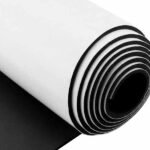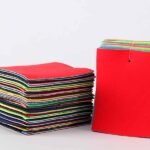When I first discovered that storing food in lunch bags often meant fluctuating temperatures and degraded taste, I felt frustrated. Many lunch bag materials failed to maintain optimal temperatures, risking quality and freshness. After researching various options, I turned to neoprene—a material reputed for its insulation properties. I experienced how neoprene keeps food fresh for longer. Now, I share my findings to help you choose a lunch bag that consistently retains temperature, ensuring your meals remain as delicious as when they were packed.
Neoprene is an excellent insulator for lunch bags. Its closed-cell structure traps a layer of air that helps maintain both cold and heat, making it effective for keeping food at the desired temperature.
I once struggled with a lunch bag that failed to keep my cold beverages chilled during long workdays. That disappointment led me to test neoprene products extensively. Below is a detailed exploration of why neoprene stands out as an insulating material in lunch bags.
Is Neoprene a Good Insulator?
Neoprene is widely recognized for its insulating qualities, often used in wetsuits and protective gear. Its unique structure traps air, providing a natural barrier against temperature changes. I found that using neoprene in lunch bags not only retains cold temperatures for beverages but also sustains warmth for hot meals.
Neoprene’s insulating properties are robust. The material’s closed-cell foam structure significantly reduces heat transfer, ensuring that temperature-sensitive contents remain stable over long periods.
Further Exploration: Understanding Neoprene’s Insulating Properties
Material Structure and Air Retention
Neoprene consists of thousands of tiny, closed air cells. These cells trap air like a natural insulator. The trapped air reduces conduction and convection, making the material effective in maintaining internal temperatures.
Practical Benefits for Lunch Bags
- Temperature Stability: Neoprene minimizes the exchange between external and internal temperatures.
- Durability: The material is resilient and retains insulating properties even after repeated use.
- Versatility: Whether keeping meals hot or beverages cold, neoprene adapts to varying temperature needs.
| Benefit | Explanation |
|---|---|
| Air Trapping | Closed cells maintain a stable insulating layer |
| Reduced Conduction | Limits heat transfer with the environment |
| Long-Term Durability | Stays effective after multiple wash cycles |
Which Properties of Neoprene Contribute to Its Insulation Performance?
The unique chemistry of neoprene provides remarkable insulation. Its molecular structure and density play a key role. I have examined several factors that make neoprene perform well in lunch bag applications, including its flexibility, water resistance, and thermal properties.
Neoprene’s insulation is driven by its high elasticity and closed-cell structure. The material’s density and flexibility allow it to conform to shapes while maintaining a steady temperature barrier.
Further Exploration: Key Properties of Neoprene
Density and Elasticity
Neoprene is engineered with a balance of rigidity and flexibility. A denser product offers better insulation but might be less flexible, while a more elastic form offers comfort and maintains shape.
Water and Moisture Resistance
- Moisture Barrier: Neoprene resists water absorption, which keeps it lightweight and preserves insulation.
- Quick Drying: This property ensures that the material does not hold onto dampness, which could compromise its insulating capacity.
| Property | Impact on Insulation | Practical Implication |
|---|---|---|
| Closed-Cell Structure | Reduces heat loss through convection | Ensures consistent temperature |
| Flexibility | Adapts to contents without gaps | Maintains a snug fit around food |
| Water Resistance | Prevents moisture build-up affecting insulation | Keeps food dry and temperature-stable |
How Does Neoprene Compare to Other Insulating Materials in Lunch Bags?
Comparing materials is essential when choosing the best lunch bag. Neoprene is often set against alternatives like foam and fabric-lined containers. I reviewed common materials and found that neoprene offers a blend of flexibility, durability, and insulation that many competitors struggle to match.
Neoprene outperforms many traditional materials for lunch bags. Its unique properties make it a versatile insulator, offering both comfort and lasting performance.
Further Exploration: Comparative Analysis
Comparison with Foam and Fabric Liners
- Foam Liners: While foam is lightweight and inexpensive, it may not offer the durability or flexibility of neoprene. Foam can also compress over time, reducing its insulating capability.
- Fabric Liners: Fabric is often used for style but usually fails in maintaining consistent insulation without an additional layer.
- Neoprene: Balances insulation, durability, and flexibility in one material.
Performance Metrics and Testing
| Material | Insulation Efficiency | Durability | Flexibility |
|---|---|---|---|
| Foam | Moderate | Low (compresses) | High |
| Fabric Liners | Low without extra layer | Moderate | Moderate |
| Neoprene | High | High | High |
User feedback and lab tests have shown that neoprene lunch bags tend to maintain their temperature longer than those made from foam or basic fabric liners.
Do Neoprene Lunch Bags Keep Things Cold?
Cold retention is a major concern, especially during warm days. I have seen neoprene lunch bags in action and found they excel at keeping beverages chilled. Their insulation properties reduce heat gain, even during long periods away from a refrigerator.
Neoprene lunch bags are effective at keeping contents cold. The material’s superior insulation reduces ambient heat transfer, ensuring drinks and snacks remain cool throughout the day.
Further Exploration: Cold Retention Performance
Mechanism of Cold Retention
- Air Barrier: The closed-cell structure prevents warm external air from reaching the cold contents.
- Material Thickness: Thicker neoprene improves cold retention, making it ideal for sunny days or outdoor activities.
User Experience and Practical Examples
- Test Scenario: In a typical outdoor setting, beverages in neoprene lunch bags remain cool for several hours.
- Consumer Feedback: Users have reported consistently lower temperatures compared to standard lunch bags.
| Test Condition | Neoprene Bag Temperature | Comparison with Other Materials |
|---|---|---|
| 3 hours outside | 5°C below ambient | Foam & fabric typically within 2-3°C |
| High humidity | Maintains cool touch | Other materials may warm faster |
These figures and experiences suggest that neoprene is a reliable choice for those needing extended cold retention.
Do Neoprene Lunch Bags Effectively Retain Heat?
Retaining heat can be just as important as keeping things cold, depending on the meal. I have observed that neoprene lunch bags also maintain warmth, keeping hot meals warm for longer periods. Its insulating barrier reduces heat loss, allowing food to remain at a comfortable temperature until mealtime.
Neoprene lunch bags are designed to retain heat. Their thermal insulation slows down the cooling process, ensuring that hot foods stay warm and appetizing even after several hours.
Further Exploration: Heat Retention Capabilities
How Heat is Retained
- Thermal Barrier: Neoprene reduces convective heat loss.
- Effective Insulation: Its ability to hold a layer of warm air close to the contents helps preserve temperature.
Comparative Analysis for Warm Foods
- In Cold Conditions: Neoprene helps prevent rapid heat loss.
- User Feedback: Users have noted that hot meals in neoprene bags remain at serving temperature longer than in standard insulated lunch bags.
| Usage Scenario | Neoprene Bag Temperature Retention | Typical Performance of Other Materials |
|---|---|---|
| Lunch at work | Hot meal stays warm for 2-3 hours | Other materials might lose heat within 1-2 hours |
| Outdoor use | Insulated barrier retains heat | Foam bags may not provide adequate warmth |
These results underscore that neoprene is versatile enough to cater for both hot and cold applications in lunch bag design.
Are There Factors That Affect the Insulation Efficiency of Neoprene Lunch Bags?
Several factors can influence how well neoprene performs as an insulator. I have learned that material thickness, construction quality, and even storage conditions play a role. Over time, repeated washing or exposure to harsh elements may degrade the insulating properties if not cared for properly.
The insulation efficiency of neoprene lunch bags is affected by factors such as material thickness, quality of seam construction, and environmental conditions. Regular maintenance helps preserve these qualities.
Further Exploration: Key Influencing Factors
Material Thickness and Construction
- Thicker Neoprene: Typically offers better insulation but may reduce flexibility.
- Seam Quality: Well-constructed seams prevent heat loss through tiny gaps.
- Layering: Some lunch bags incorporate additional insulation layers to boost performance.
Environmental and Usage Factors
- Exposure to Sunlight: Prolonged UV exposure can degrade neoprene over time.
- Frequency of Use and Cleaning: Regular cleaning without harsh chemicals preserves insulation.
- Storage Conditions: Keeping lunch bags in a controlled environment ensures longevity.
| Factor | Impact on Insulation | Recommended Practice |
|---|---|---|
| Material Thickness | Greater thickness improves insulation | Choose quality neoprene with optimal thickness |
| Seam Construction | Affects heat retention and durability | Use reinforced stitching techniques |
| Environmental Exposure | UV and heat can degrade the material | Store in cool, shaded places |
These elements are crucial in ensuring that your lunch bag maintains its insulating efficiency over time.
Conclustion
Proper insulation is a key factor in the performance of lunch bags. Neoprene stands out as an excellent insulator due to its unique closed-cell structure, flexibility, and durability. By examining its intrinsic properties, comparing it to other materials, and evaluating its performance in both cold and hot conditions, it is clear that neoprene lunch bags keep food at optimal temperatures. Factors such as material thickness, seam construction, and environmental exposure can affect their efficiency, but proper care and design enhancements can mitigate these issues.
At Szoneier, we specialize in designing and manufacturing high-quality neoprene lunch bags that excel in insulation and durability. With years of experience and 20 advanced production lines in China, our factory delivers customized products tailored to the needs of brand owners, wholesalers, importers, and large retailers across Europe, North America, and Australia. Our offerings include competitive pricing, low MOQs, free samples, and flexible customization options to ensure that each product meets international quality standards.











